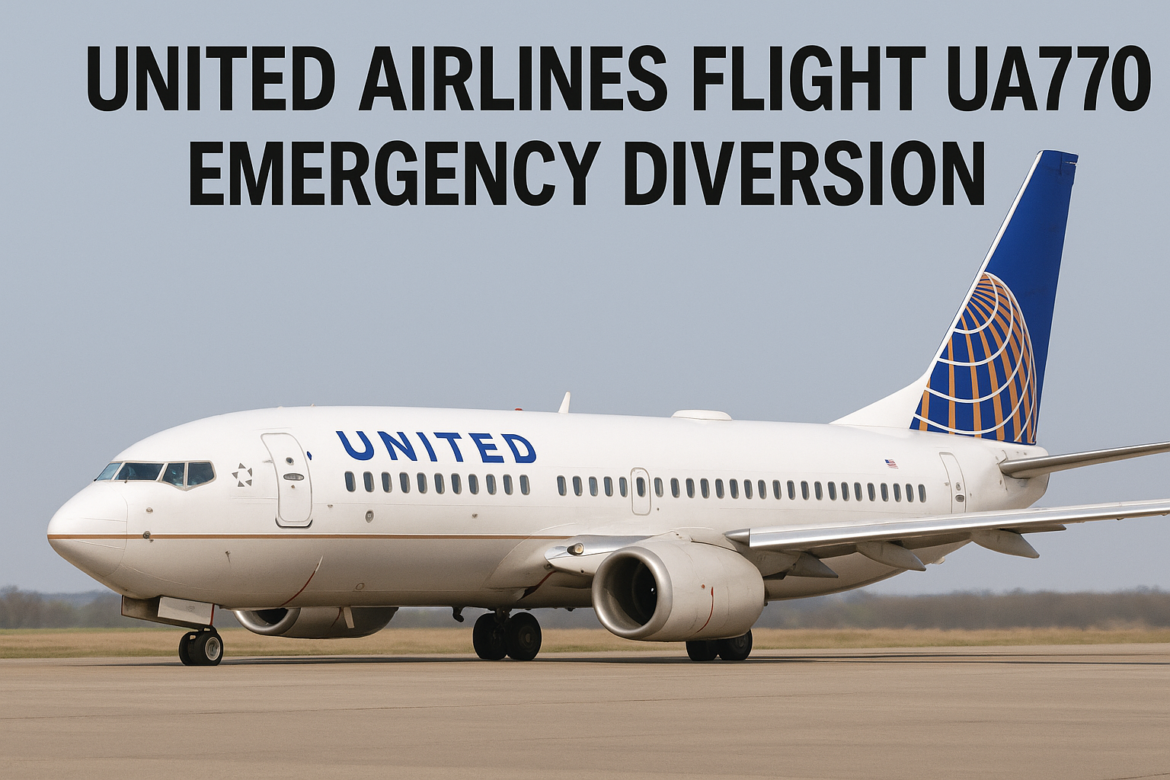A routine transatlantic flight turned nerve‑wracking when United Airlines Flight UA770, en route from Barcelona to Chicago, declared an in‑flight emergency and diverted to London Heathrow. Fast, decisive action by the crew shifted what could have become a crisis into a textbook case of aviation safety in action. Here’s what really happened—and why it matters.
The Flight Path That Wasn’t: UA770’s Route Redefined
Scheduled Journey
UA770, operated by a Boeing 787‑9 Dreamliner (tail N26902), was flying from Barcelona El Prat Airport (BCN) to Chicago O’Hare (ORD), a typical transatlantic route buzzing with passenger traffic .
Mid‑Air Emergency
About 90 minutes after departure, while cruising at approximately 37,000 ft over the Atlantic, the cockpit crew detected a cabin pressurization anomaly. Pilots declared a general emergency by squawking 7700—a universal code indicating a serious situation .
Immediate Diversion to Heathrow
ATC swiftly rerouted UA770 to London Heathrow—a major international hub capable of handling large aircraft and emergency procedures—ensuring fast landing clearance and emergency preparedness .
Onboard: What Passengers Experienced
Tense Moments in Cabin
Though no panic broke out, passengers described sudden pressure changes and crew announcements. Some passengers noted oxygen masks deployed briefly as a precaution. The cabin crew maintained calm, clear communication throughout
Crew Performance Praised
Travelers repeatedly praised the crew’s composure. “They stayed calm, kept us informed,” shared one passenger online—a sentiment echoed across social channels
Why Squawk 7700 Matters: The Aviation Emergency Code
What It Signifies
Squawking 7700 alerts all ATC facilities that the aircraft faces an emergency—automatically granting it priority in routing, clearance, and landing
System Designed for Safety
While alarming to passengers, such diversions highlight aviation’s layered emergency protocols. In this case, the crew’s early decision prevented escalation
After Landing: Handling Crisis on the Ground
Safe Arrival and Inspection
UA770 landed safely at Heathrow’s Runway 27R. Emergency vehicles were on standby, but no injuries occurred. The aircraft underwent rigorous pressurization diagnostics and was grounded pending further checks
Aircraft Status
Initial inspections revealed no structural damage. However, the pressurization system required detailed evaluation before clearance for subsequent service
United Airlines’ Response to the Incident
Official Statement
United acknowledged the precautionary diversion due to a technical issue and reaffirmed its priority on passenger safety. Crew professionalism and prompt handling were highlighted
Passenger Support Measures
Affected passengers received real‑time updates, rebooking options, meal vouchers, and, where needed, hotel accommodations. Mobile app and email channels provided status alerts and support information
What Triggered the Diversion? Possible Causes
Pressurization Alert
Multiple sources point to a cabin pressurization fault—likely a sensor or valve issue—as the triggering event for diversion. While United hasn’t publicly confirmed exact cause, aviation experts lean toward this scenario
Why Such Issues Matter
Even minor fluctuations in pressure at high altitude can lead to oxygen mask deployment, hypoxia risk, and fast decisions. Protocol calls for immediate descent and diversion when anomalies are detected .
Timeline of Events: UA770 From Departure to Landing
| Time (Approximate) | Event |
|---|---|
| Flight departs BCN as scheduled | Normal departure |
| ~90 minutes into flight | Pressurization anomaly detected |
| Crew squawks 7700 | Declares general emergency |
| Diversion initiated to Heathrow | ATC route change |
| Landing at LTBR Runway 27R | Safe arrival |
| Passengers disembark | Guided by crew |
| Ground inspections begin | Maintenance checks initiated |
This timeline aligns with multiple credible reports and reflects UA770’s progression from calm flight to controlled emergency handling .
Broader Context: Diversions, Safety, and Trends
How Common Are Diversions?
Emergency diversions are rare—estimated at 0.01% or fewer of all flights. Many are precautionary, not crisis responses, reflecting improved detection and training, not deteriorating safety .
United’s Safety Protocols
The airline emphasizes recurring emergency training, simulator drills, sensor diagnostics, and strict protocols. UA770’s handling underscored training effectiveness .
Real Passengers, Real Feelings: Voices From the Cabin
First-hand accounts cited professionalism and reassurance from the flight crew. One passenger commented:
“We were told something was up, but the crew stayed calm, and that helped us stay calm too.” .
These human moments—fear, relief, trust in the crew—shape a narrative far more authentic than any automated summary.
FAQs: What Travelers Most Want to Know
1. What exactly triggered the UA770 emergency diversion?
Crew reported a cabin pressurization anomaly at cruising altitude. While the precise sensor or valve involved hasn’t been specified, the response aligned with safety protocols for such scenarios .
2. Was anyone injured during the emergency landing?
No. Passengers disembarked safely without physical injury. A few were evaluated by medical staff as a precaution due to mild anxiety or discomfort .
3. Why Heathrow rather than another nearby airport?
Heathrow was the nearest major international airport equipped to handle a Boeing 787‑9 with full emergency resources—fire, medical, runway, and maintenance support .
4. What happens after such a diversion?
The aircraft is grounded pending diagnostics of the reported issue. Meanwhile, passengers receive rebooking, vouchers, and assistance. United’s maintenance and ground teams work quickly to assess airworthiness .
5. Are diversions like this common?
They’re rare—less than 1% of flights. Most are proactive responses to sensor alerts or anomalies rather than evidence of critical failure .
Conclusion
United Flight UA770’s emergency diversion from Barcelona to Heathrow was unsettling for those aboard, but ultimately showcased aviation at its best: emergency systems and protocols functioning exactly as designed. From the initial pressurization fault to the swift declaration of squawk 7700, to the safe landing and passenger care—every step reflected disciplined crew action and priority on safety over schedule. Though rare, such events build trust when handled well. For flyers, it’s a reminder: stay calm, follow crew instructions, and trust the training behind every emergency decision.

